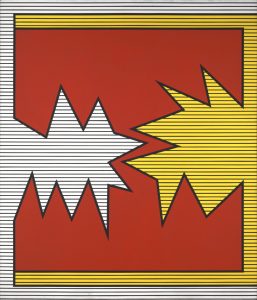
Lesson Concept: Observational Poetry
We can look at art to analyze and interpret the ideas at play; we can also use art as a prompt for creativity, but these two things don’t have to be mutually exclusive. Use this simple creative writing exercise to help students collaboratively use creative thinking in tandem with critical thinking as they make meaning from abstract artworks.
Objectives
- Students will use both creative and critical thinking as they engage with a work of art whose meaning may not be immediately clear.
- Students will document their responses to the abstract ideas presented by a work of art and collaboratively generate a poem based on those responses.
Activity
Adjust this activity in whatever way makes sense for your classroom. The instructions below are merely an outline for students to document their thinking.
Invite students to use the steps below to spend at least 10-15 minutes with a work of art, challenging them to work collaboratively to creatively document the ideas it presents to them.
Ask them to refrain from reading information about the art until they have generated their poems and reflected on their own creative process.
Choose from the objects below or visit the VMFA Collections page to search for other possibilities:
Generate a Word List
- Spend at least 2 full minutes looking carefully at this work of art. Let your eyes wander all over the image.
- As you are observing, create a list of words. Try to generate a list of at least 20 words.
- These words can be adjectives, nouns, a feeling, something the piece reminds you of – they can be anything as long as they come out of your reaction to the piece and what you are observing in it.
- Note: it is important for the exercise that your list contains just words and not phrases
Generate a Poem
- Get into groups of three or four.
- As a group, write a poem that incorporates words from each person’s list.
- The poem can be in any form you like – a few examples: haiku, rhyming couplet, free verse
- Include as many words from your lists as you like, but you must include at least one word from each group member’s list.
Discussion
- Share your group’s poem with the class.
- What words from your lists did you incorporate into your poem?
- What particular aspects of the artwork brought those words to mind?
- Read the title and label copy about the artwork. How do the ideas your poem expresses compare?
- Reflect on this process. What was difficult about the activity? What came easily?







